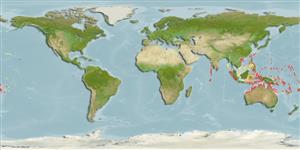Common names from other countries
>
Anguilliformes (Eels and morays) >
Chlopsidae (False morays)
Etymology: Kaupichthys: Because of Johann Jakob Kaup, 1827; author of "Zoologische Monographien", ichthyologist + Greek, ichthys = fish.
More on author: Schultz.
Environment: milieu / climate zone / depth range / distribution range
Ecologia
marinhas associadas(os) a recifes; intervalo de profundidade 1 - 20 m (Ref. 86942). Tropical; 30°N - 24°S
Indo-Pacific: Chagos Islands to Samoa, north to Ryukyu Islands, south to the southern Great Barrier Reef; throughout Micronesia.
Tamanho / Peso / Idade
Maturity: Lm ? range ? - ? cm
Max length : 12.0 cm TL macho/indeterminado; (Ref. 30874)
Descrição breve
Chaves de identificação | Morfologia | Morfometria
Vértebras: 107 - 112.
A small uncommon species which inhabits coral heads to depths of at least 14 m.
Life cycle and mating behavior
Maturities | Reprodução | Spawnings | Egg(s) | Fecundities | Larvas
Myers, R.F., 1991. Micronesian reef fishes. Second Ed. Coral Graphics, Barrigada, Guam. 298 p. (Ref. 1602)
Categoria na Lista Vermelha da IUCN (Ref. 130435)
CITES (Ref. 128078)
Not Evaluated
Ameaça para o homem
Harmless
Utilização humana
Ferramentas
Relatórios especiais
Descarregue XML
Fontes da internet
Estimates based on models
Preferred temperature (Ref.
115969): 25.2 - 29.3, mean 28.5 (based on 1596 cells).
Phylogenetic diversity index (Ref.
82804): PD
50 = 0.5156 [Uniqueness, from 0.5 = low to 2.0 = high].
Bayesian length-weight: a=0.00102 (0.00046 - 0.00225), b=3.06 (2.88 - 3.24), in cm Total Length, based on all LWR estimates for this body shape (Ref.
93245).
Nível Trófico (Ref.
69278): 3.6 ±0.5 se; based on size and trophs of closest relatives
Fishing Vulnerability (Ref.
59153): Low vulnerability (10 of 100).
